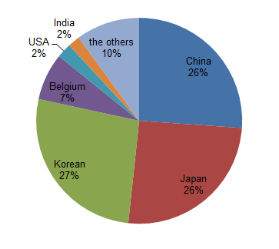In the context of the worsening Ukraine crisis and Crimea merger, Russia is economically punished with burdensome measures by Europe and United States. These new punishing measures include: Russian banks and enterprises, especially enterprises of oil and gas industry are restricted to get access to European Market; high-tech goods are restricted to export to Russia, travel ban and freezing assets of Russian senior officials, Europe makes effort to reduce independence on Russian’s energy supply. All the above factors weaken Russia’s relationship with the West. Moreover, the United States would like to aim at the Asia — Pacific Region, which makes Russia aim at the East through enhancing relationship with countries in the Asia — Pacific Region.
One of the Russian strategies is to concentrate on developing the Far East, which makes Russia have a standing place as well as outstanding economic and political role in the Asia — Pacific Region.
- Overview of the Far East.
The Far East is the biggest federal region in 8 federal regions of Russia. The Far East has the main territory in Asia and stretches in 4 time zones. This region has the special geographic position: bordering on the Ural Mountains in the west, the Arctic Ocean in the north, the Pacific Ocean and a part of American territory through Bering Strait in the east, bordering on China and North Korea in the south. Therefore, the Far East has a very important geographic position — the connecting, traffic, strategic position in economic cooperation of the Russian Federation and Asia — Pacific region.
The Far East has an area of over 6 million km2, accounting for 36 % of the Russian Federation’s area with population of 6.440.000 people (2010). The Far East territory stretches along the Pacific shore of 4.500 km.
This region is rich in natural resources not much exploited, especially mineral, marine and forests resources. Estimated petroleum reserves are about 18 billion tons and estimated gas reserves are about 25 billion m3. Brown coal, stone coal and coke reserves correspondingly account for 61, 38 and 20 % of reserves of Russian Federation. Diamond accounts for 81 % of reserves of the Russian Federation. The corresponding rate for gold is over 50 %. The whole region has up to 4000 mines of gold, in which 130 big mines gather in Magadan, Amur, Khabarov, Iacutia, and Chukotca. Silver reserves account for 85 % of reserves of the whole Federation and tungsten 23 %, lead 20 %. In addition, in this region, there are different types of minerals as well as remarkable reserves of zinc, platinum, apatite, manganese, potassium etc.
Forest accounts for 40 % of territory. Wood accounts for 33 % of reserves of the whole federation. Wood trees account for 60 % of Far East area.
- Economic characteristics of the Far East.
Economic sector structure. Economic sector structure of the Far East is much diversified. Mining sector accounts for the biggest proportion, 24.7 %. Transport and communication occupy the second position with 13.4 %. Construction sector accounts for 12.2 %, trade 10.2 %. Furthermore, finance and service sectors account for 7.3 %; agriculture, forestry and fishery account for 6.5 %, processing industry accounts for 5.6 % and other sectors.
Foreign economic relations.
Table 1
Total import-export turnover of the Far East in 2008–2011, (billion USD)
|
Year |
2008 |
2009 |
2010 |
2011 |
|
Total turnover |
17.71 |
13.0 |
25.5 |
34.0 |
(Source: Department of European Market — Ministry of Industry and Trade)
In 2008, total commercial turnover of the Far East with countries in the region achieves 17.71 billion USD. In 2009, due to effect of world economic crisis, the total turnover is only about 13 billion USD, reducing by 4.71 billion USD (27 %) in comparison with 2008. However, after crisis, the economy of the Far East is gradually stable. Total export turnover of the Far East in 2010 achieves 25.5 billion USD, twofold increase in comparison with export-import turnover in 2009. In 2011, export-import turnover of the Far East continues to increase by 8.5 billion USD in comparison with 2010.

Figure 1. Commercial relationship between the Far East and some countries (Source: Department of European Market — Ministry of Industry and Trade, 2012)
Countries have the biggest foreign trade turnover with the Far East is China (26.1 %), Japan (25.6 %), Korean (26.7 %), Belgium (7.4 %), United States (2.3 %), India (1.9 %), Thailand (0.4 %), Taiwan (0.8 %), Hong Kong (0.5 %).
Main export goods of the Far East is types of energy goods (petroleum, coal, gas and liquefied coal); gemstone, precious metal and their products; food products and agricultural material; fish, molluse and other aquatic creatures; machines, equipment’s and transport vehicles; wood and pulp; metal and products from metal etc. Goods imported by the Far East are machines, equipment’s and transport vehicles; cloth and fabric products, shoes, sandals, leather, animal fur, chemical industry products, rubber; food and agricultural products; fish, shrimp and molluse; mineral water.
Unique strategic position of the Far East. The Far East of Russia consists of an economic area along the 200-mile coast. This is an important factor to make a unique strategic position of the region. As estimated, this economic area has an area of about 5 million km2. Russia has sovereignty on natural resources of this area. Therefore, the Far East can develop sustainably and effectively and is a gateway to Pacific Ocean and oceans in the world, political geographic relationship between Russia and countries in North Pacific Ocean. We can see that political geographic position of the Far East is unique because of the following reasons:
- The Far East borders on the Pacific — a central area of the world and the Northeast of the Eurasian region — a large region connected with the Pacific Ocean. Moreover, Russia has the same border with biggest countries in the world such as America, China and Japan.
- The Far East has the unique geographic position, therefore it has a diversified traffic network with many wharfs, railways etc. to perform the function connecting regions.
- The Far East has diversified unique natural resources (including renewable land and sea resources), which has important contribution to Russian geo-strategy.
- The Far East is a region combining geopolitical interests of world’s leading countries; therefore this region is always eventful with activities of naval forces and merchant ship in the region.
- The Far East is a region of sea natural resources, many of which are in the open sea and in the 200-mile economic region. This contributes much to its geopolitical potential.
3. The Far East development solution in the role of connecting the economy of Russian Federation with Asia-Pacific region/
Through the above analysis, we can see the important role of the Far East for Russia in the context of integration of Russia with Asia — Pacific region. Thanks to awareness of such role, Russian government has approved «Strategy for socio-economic development of the Far East and Baikan region until 2025» according to 3 stages:
− Stage 1 (2009–2015): Hastening the investment growth speed for this region, developing energy-saving technology, increasing job chances for employees.
− Stage 2 (2016–2017): Building large-scale energy projects, increasing passenger transport and transit goods transport, setting up core transport network, increasing production and export of goods and materials.
− Stage 3 (2021–2025): Developing the economy according to creative development model, exploiting large-scale petroleum and gas sources, rebuilding large-scale projects on energy and transport.
Furthermore, the Government has performed federal target programs such as: «Developing the socioeconomic Far East region and Far East areas until 2018» and «socioeconomic development of Kuril (Sakhalin) archipelago in the stage 2007- 2015». The long-term strategic target is to perform geopolitical missions to ensure population formation and development in the Far East and Baikan through economic development, creating favorable environment for people’s life in provinces in this regions. To achieve this target, it must be ensured that the Far East has favorable conditions to develop with the speed equal or higher than the average level of the Russian Federation and solve series of imminent missions, specifically:
Setting up conditions of professional economic development of provinces in the Far East on the basis of potential on natural reserves, industry, scientific and officer capacity in the framework of sec-tor development strategy of the Russian Federation, socioeconomic development strategy of Russian Federation and strategic development program of big companies and groups.
− Forming a firm population distribution system based on regions with high economic growth level in combination with creating a convenient living environment for people.
− Reducing barriers for socioeconomic integration of the Far East with other regions of Russia, enhancing competitiveness of products, goods and services in accordance with economic sector by creating legal frameworks to determine special policies on conditions of price, tax, customs, budget etc.
− Building up the population and labor forces necessary for solving economic matters in the region, enhancing quality of human resources.
− Enhancing international cooperation on economy, investment, trade between provinces in the Far East with countries in the world, building the Far East into a representative region for Russia in international relationship with countries in the Asia — Pacific region.
− Preserving and proving the traditional lifestyle of ethnic groups of the North Russia.
Conclusion. In the current context, enhancing relationship with countries in the Asia — Pacific region has a very important strategic meaning for future of Russia. Countries in this region are still important goods and services consuming markets of the world, which ensure quick economic growth for this region. Simultaneously, Russia sets a target of developing the Far East — the region with the important economic and political geographical location not only for Russia but also for countries in the region — into a main socioeconomic center of Russia to integrate with the Asia — Pacific region effectively.
From next 10 to15 years, developed economic conditions, improved traffic and convenient geographical position will create an environment for the Far East of Russia to become «energy bridge», enlarge economic cooperation, commercial exchange with countries in the region, especially with big economies such as China, Japan, Korea, ASEAN countries about products such as electrical energy, forest product, seafood and high-tech products to make the Russian economy integrate deeply into the Asia — Pacific region.
References:
- Chikahito Harada. Russia and North-East Asia. International Institute for Strategic Studies, 2002.
- Tsuneo Akaha. Politics and Economics in the Russian Far East: Changing Ties with Asia Pacific, Taylor Franci, 2002.
- Pyotr Baklanov, Matvey Romanov. The Unique Geopolitical Position of Pacific Russia. Far East Affairs from current issue, 1, 2014, P.30.
- Thornton Charles E. Ziegler. Russia's Far East: A Region at Risk. The National Bureau of Asian Research, 2002.
- Kuchin A. C., Zevelev I. A. (2012). Russian Foreign Policy: Continuity in Change. The Washington Quarterly, 2012.







